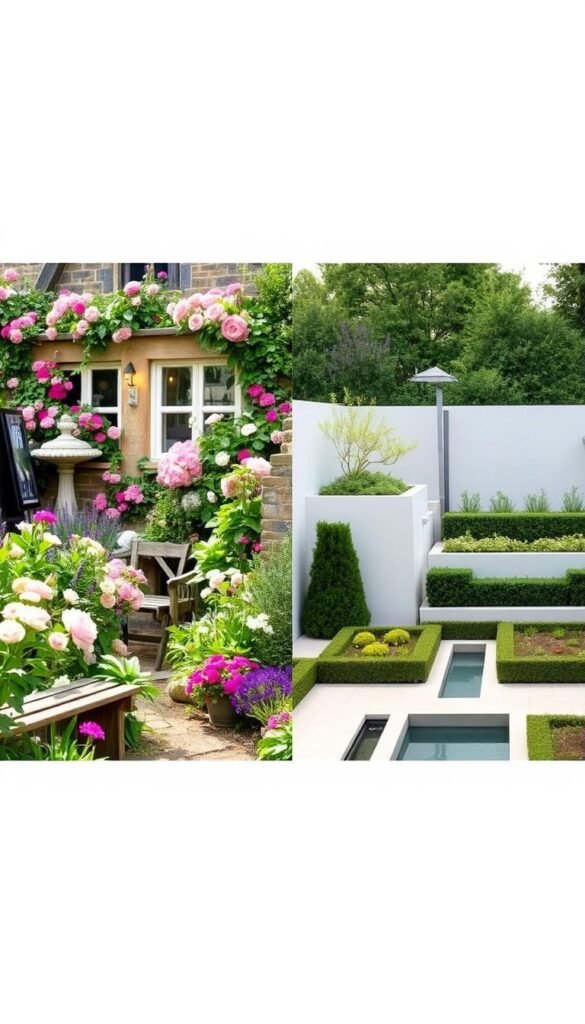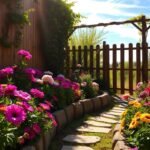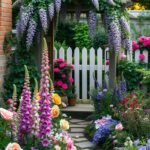Feeling overwhelmed by endless landscaping ideas? You’re not alone. With so many approaches – from lush meadow layouts to sleek geometric patterns – designing your yard can feel like navigating a maze. Here’s the good news: most outdoor designs fit into four simple categories that help simplify your choices.
Traditional layouts offer timeless symmetry, while free-flowing plant arrangements define relaxed, nature-inspired spaces. Clean-lined contemporary concepts prioritize simplicity, and structured formal designs bring classic elegance. The secret? You don’t need to pick just one.
Your personal preferences and daily routines matter most when shaping your space. Do you love hosting barbecues or prefer low-maintenance areas? Want vibrant colors or calming neutrals? These factors determine which elements work best for your lifestyle.
This guide breaks down key differences between two popular approaches – one bursting with colorful blooms and another favoring clean lines. You’ll learn how to blend textures, shapes, and materials to create an outdoor area that feels authentically yours. Ready to transform your yard into a personalized retreat?
Understanding the Basics of Garden Styles
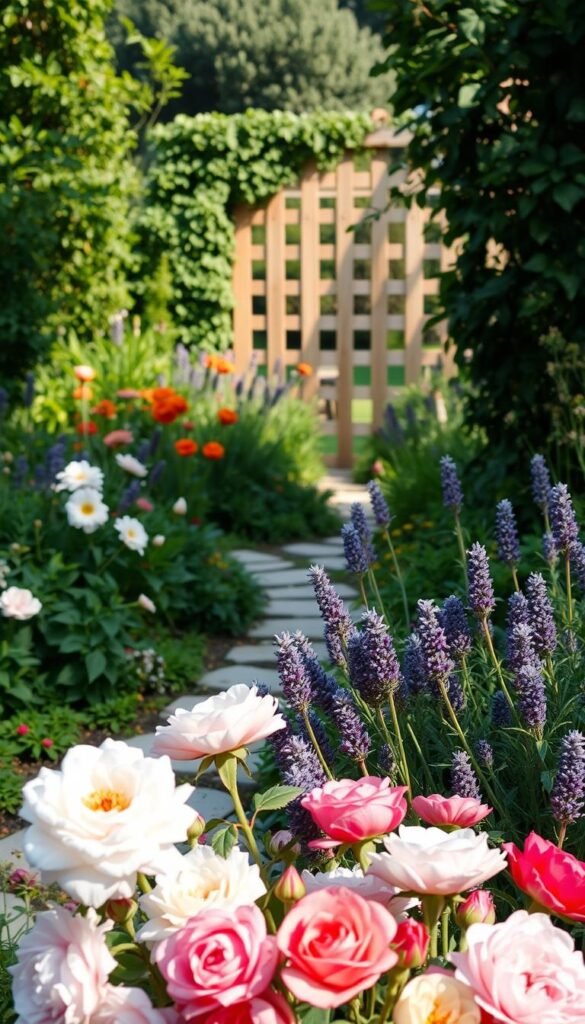
Designing your outdoor space starts with recognizing core landscape patterns. Bower & Branch identifies eight primary garden styles, each offering distinct vibes and structures. Whether you lean toward geometric precision or untamed beauty, these categories help narrow your vision.
Breaking Down the Options
Here’s a quick guide to popular design styles and their key traits:
| Style Name | Key Features | Best For |
|---|---|---|
| Modern | Clean lines, monochromatic tones | Urban spaces |
| Naturalistic | Wild plantings, native species | Low-maintenance lovers |
| Eclectic | Mixed textures, bold contrasts | Creative experimenters |
Discovering What Speaks to You
Your landscape should mirror what makes you feel at ease. Take walks to notice which elements catch your eye—maybe sculptural shrubs or overflowing flower beds. Bookmark Pinterest ideas that spark joy, but remember: real-life conditions matter more than photos.
“Your yard isn’t a magazine spread—it’s a living space. Prioritize what works for your climate and routine.”
Mix and match freely. A formal hedge could frame a relaxed seating area, or gravel paths might weave through wild grasses. Your design choices should balance beauty with how much time you’ll spend pruning or watering.
Embracing the Cottage Garden Aesthetic
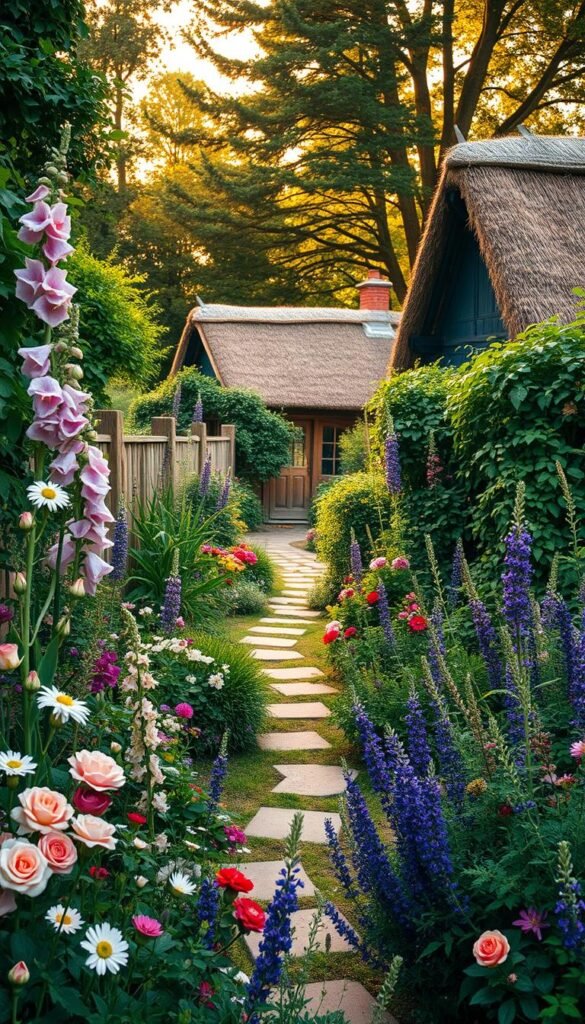
What if your yard could feel like a storybook illustration? This approach celebrates imperfections, where roses climb weathered fences and herbs mingle with peonies. It’s not about rigid rules—it’s about crafting spaces that whisper secrets of generations past.
The Charm of Natural Wildness and Romance
Imagine lavender brushing against your ankles as you walk winding stone paths. This aesthetic thrives on layered textures—feathery grasses dancing with velvety sage leaves, climbing vines softening angular fences. Colors blend freely, with soft pinks melting into bold purples like watercolor strokes.
Seating areas nestle among blooms, creating intimate nooks perfect for morning coffee. Everything feels discovered rather than placed, as if nature gently arranged each detail. Annuals reseed where they please, adding surprises to next year’s canvas.
Key Elements: Abundant Flowers, Textures, and Intimacy
Vertical spaces become living art with clematis-covered arbors. Edible chives border peony bushes, while mint spills from cracked teacups repurposed as planters. Every surface tells a story through:
- Timeworn benches doubling as strawberry planters
- Rustic gates draped in sweet pea vines
- Hand-painted signs peeking through foxgloves
This approach maximizes small areas through strategic density. Tall hollyhocks screen utility areas, while thyme carpets walkways. The result? A space that feels both abundant and deeply personal—like your favorite well-loved quilt.
Modern Minimalist Garden: The Essence of Clean Design
Imagine stepping into a space where every element serves a purpose and whispers sophistication. Modern minimalist design transforms outdoor areas into serene extensions of your home, blending intentional simplicity with striking geometry. This approach celebrates empty spaces as much as filled ones, letting each feature breathe.
Emphasis on Clean Lines and Geometric Forms
Sharp angles and uncluttered layouts define this style. Picture rectangular concrete planters holding sculptural succulents, or sleek metal benches mirroring horizontal fencing. Repetition creates rhythm—think identical boxwood shrubs spaced like living punctuation marks.
Hardscapes take center stage here. Materials like polished concrete or weathered wood form crisp pathways, while gravel beds contrast with smooth surfaces. The magic lies in restraint: a single statement tree or angular water feature becomes the hero.
Selecting Noble Materials and a Subtle Color Palette
Neutral tones ground the space, letting textures shine. Charcoal pavers meet warm cedar screens, creating depth without chaos. Plants follow the same rule—silvery olive foliage or burgundy Japanese maples add muted drama.
Contemporary gardens often incorporate modern outdoor spaces designed for relaxation. A curved teak bench might soften rigid lines, while strategic lighting turns steps into art after dark. As one designer notes: “Minimalism isn’t about absence—it’s about precision.”
Comparing Key Design Principles Across Garden Styles
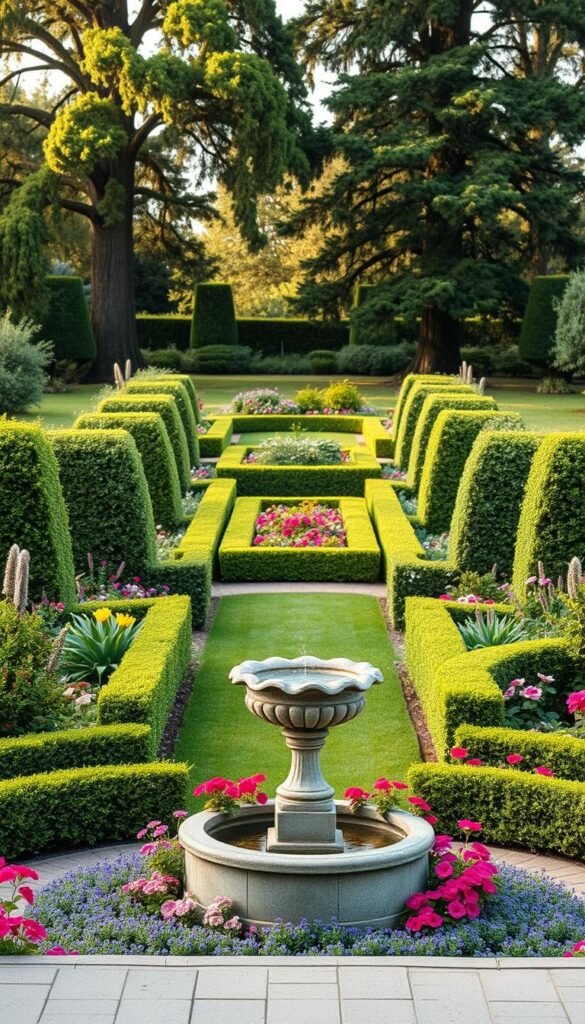
Great design speaks through balance—whether through strict geometry or nature’s freeform rhythms. Let’s explore how different approaches handle structure and create visual harmony.
Symmetry and Structure Versus Organic Complexity
Traditional layouts use mirror-like precision. Think paired hydrangeas flanking stone steps or boxwood hedges trimmed into crisp shapes. These spaces feel formal yet timeless, perfect for those who love order.
Modern gardens flip the script. Instead of mirror images, they play with interlocking rectangles of lawn and patio. A single sculptural tree might offset angular concrete planters, creating tension that feels intentional.
| Style | Structural Approach | Focal Points |
|---|---|---|
| Traditional | Bilateral symmetry | Central fountain |
| Modern | Asymmetrical balance | Geometric planter |
| Naturalistic | Undulating forms | Native tree grove |
Relaxed styles borrow underlying geometry but soften edges. Picture curved pathways framed by billowing catmint or stone walls draped in wisteria. The bones remain organized—just hidden beneath nature’s artistry.
Naturalistic designs take cues from wild landscapes. Grasses cluster like they’ve self-seeded, while trees grow in irregular patterns. Here, structure comes from plant forms rather than human-made elements.
“Good design isn’t about rules—it’s about creating relationships between spaces.”
Your choice shapes how eyes move through the space. Formal layouts guide views toward centerpieces, while free-flowing gardens invite exploration. Mix approaches: try symmetrical patio furniture on an asymmetrical gravel base for playful contrast.
Cottage Flower Garden vs. Modern Minimalist: Finding Your Perfect Style
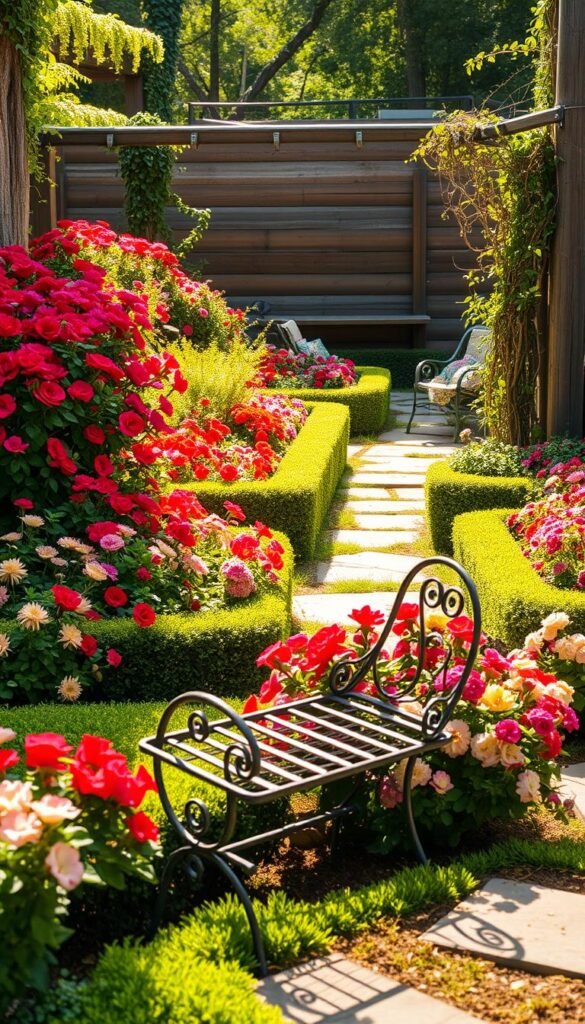
What transforms a yard from ordinary to extraordinary? The answer lies in harmonizing your vision with your land’s natural rhythm. Your outdoor area becomes an extension of your personality when its layout aligns with sunlight patterns, soil types, and daily routines.
Matching Aesthetics to Your Environment
Start by sketching sunlight hours across your space. North-facing areas suit shade-loving ferns, while south zones handle drought-resistant grasses. Existing trees or slopes? Turn them into focal points instead of obstacles. A steep incline could become a cascading succulent wall or terraced rose beds.
| Feature | Cottage Approach | Modern Solution |
|---|---|---|
| Small Patio | Vertical trellis with climbing nasturtiums | Monolithic concrete planter with ornamental grass |
| Shady Corner | Ferns + bleeding heart cluster | Geometric shade structure with built-in lighting |
| Sloping Yard | Meandering stone steps through lavender | Retaining wall with integrated seating |
Urban dwellers often thrive with modern layouts that maximize tight spaces. Think foldable furniture or raised planters doubling as privacy screens. For sprawling properties, creative gardening ideas like wildflower meadows require less upkeep than precise hedges.
“Your landscape should grow with you—start simple, then layer in complexity as your confidence blooms.”
Maintenance matters. Do weekends mean pruning shears in hand or hosting friends? Loose gravel pathways suit busy schedules, while perennial borders demand seasonal attention. Remember: Your design isn’t frozen—swap out annuals or rearrange pots as your needs evolve.
Choosing Plants and Materials for Your Ideal Garden
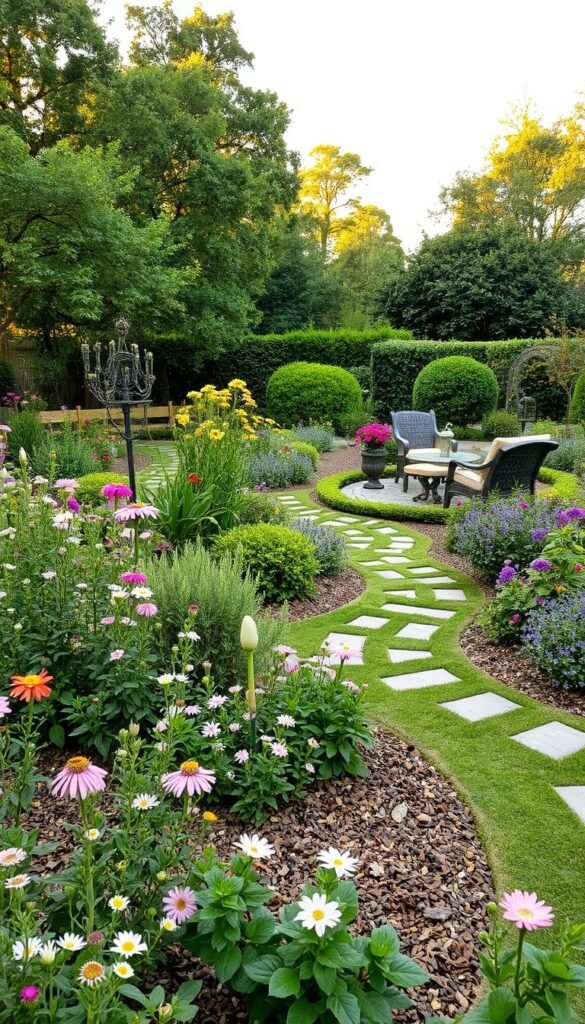
Your outdoor space comes alive when plant pairings and material textures work in harmony. Whether you crave lush layers or sculptural simplicity, these decisions shape your landscape’s character while supporting local ecosystems.
Plant Selection: From Ornamentals to Native Varieties
Diverse blooms and foliage create depth. Romantic spaces thrive when roses tumble over fences alongside thyme and sage. These mixes attract pollinators while offering herbs for kitchen use. For structure, try columnar junipers or yew hedges that frame pathways without overwhelming.
| Style | Signature Plants | Key Benefit |
|---|---|---|
| Layered Approach | Peonies, lavender, edible chives | Multi-season interest |
| Architectural Focus | Yucca, ornamental grasses, Japanese maple | Year-round structure |
Materials and Accents: Stone, Wood, Metal, and More
Pathways and borders anchor your design. Weathered stone patios complement loose planting schemes, while geometric concrete slabs highlight minimalist arrangements. Metal sculptures add modern flair when placed among ornamental grasses.
| Material | Best For | Maintenance Level |
|---|---|---|
| Reclaimed brick | Winding walkways | Low |
| Corten steel | Sleek edging | Moderate |
“Materials should whisper your style’s story—rustic charm through irregular stones or urban cool via polished concrete.”
Designing Functional and Appealing Outdoor Spaces
Your outdoor area becomes an extension of your home when zones serve distinct purposes. Smart layouts balance social hubs with private retreats, adapting to your daily rhythms. Let’s explore how thoughtful planning transforms ordinary yards into multi-functional sanctuaries.
Creating Zones for Relaxation and Entertainment
Start by mapping activities you love. A sunlit corner could host morning yoga sessions, while shaded patios accommodate evening gatherings. Water elements anchor these zones—think cascading fountains for ambient sound or geometric pools reflecting sky patterns.
| Zone Type | Cozy Style | Sleek Approach |
|---|---|---|
| Dining Area | Rustic table under flowering vines | Modular concrete seating + fire pit |
| Quiet Nook | Hammock nestled between lilacs | Floating bench beside reflecting pool |
| Play Space | Wildflower border around lawn games | Artificial turf with built-in storage |
Intimate seating thrives in hidden corners. An arbor draped in wisteria creates a fragrant reading spot, while raised planters double as privacy screens. For entertaining, define spaces with materials—flagstone circles for conversation pits or gravel squares for cocktail hours.
“Great outdoor design weaves function into beauty. Every seat should invite lingering, every path promise discovery.”
Pathways guide movement without rigid boundaries. Meandering stepping stones suit free-flowing layouts, while linear pavers echo contemporary design principles. For more ideas on elevating your gardening aesthetic, consider how lighting and plant textures enhance each zone after dark.
Using Hardscape and Softscape to Enhance Your Garden
Your outdoor space gains depth when sturdy structures meet flowing greenery. Paths guide movement while gravel adds crunch underfoot, and climbing vines soften angular trellises. These elements work together to shape experiences, whether you’re hosting friends or enjoying quiet moments.
Grounding Your Design With Purposeful Materials
Paths set your landscape’s rhythm. Traditional layouts use pea gravel for rustic charm, while modern spaces favor geometric concrete slabs. Architectural accents like pergolas add vertical interest—train jasmine up metal frames or let wisteria engulf wooden arbors.
Softening Edges With Living Layers
Lush plantings breathe life into stone and metal. Mix feathery grasses with velvety sage near gravel beds, or pair sculptural succulents with smooth concrete. These textured elements create sensory richness that changes with seasons.
Crafting Visual Balance Through Contrast
Open gravel areas let eyes rest between dense floral displays. Define seating zones with low stone walls, then let lavender spill onto walkways. This interplay between structured design and wild growth makes spaces feel both intentional and inviting.

